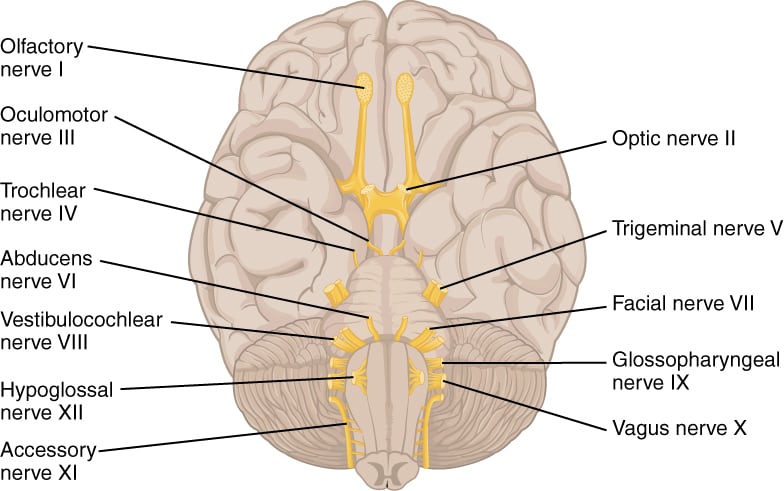There are 12 pairs of cranial nerves as given below.
| Cranial Nerve | Nuclei | Special characters |
|---|---|---|
| Olfactory (I) | Olfactory bulb | Sense of smell |
| Optic (II) | Lateral geniculate nucleus; pretectal nucleus (light reflex) | Sensory nerve; vision, coordinated eye movements; light and accommodation reflexes. |
| Oculomotor (III) | Oculomotor nucleus (motor); Edinger Westphal nucleus (parasympathetic) | Emerges from midbrain, innervates all extraocular muscles except the superior oblique and lateral rectus. Edinger Westphal nucleus supplies ciliary and constrictor pupillae muscles after passing through the ciliary ganglion. |
| Trochlear (IV) | Motor nucleus | Emerges from the midbrain and supplies the superior oblique muscle. |
| Trigeminal (V) | Motor nucleus, 3 sensory nuclei - principal sensory, mesencephalic and spinal trigeminal. | Emerges from the pons; has small motor and large sensory root; motor supplies muscles of mastication, mylohyoid, anterior belly of digastric, tensor tympani and tensor veli palatini. Sensory supply to face and head - principal sensory nucleus receives inputs of touch and pressure/ mesencephalic receives proprioceptive input from the teeth, hard palate, TM joint, muscles of mastication/ spinal trigeminal receives pain and temperature input; three divisions- V1 or ophthalmic/ V2 or Maxillary and V3 or Mandibular. |
| Abducens (VI) | Motor nucleus | Arises from the junction of the pons and medulla; nucleus lies in the floor of the fourth ventricle; supplies lateral rectus muscle. |
| Facial (VII) | Motor nucleus; sensory nucleus in solitary nucleus; parasympathetic superior salivatory nucleus | Emerges from the junction of the pons and medulla lateral to Abducens nerve; has motor and sensory roots; parasympathetic supply to submandibular and submental salivary glands; motor supply to muscles of facial expression; taste sensation from anterior two-thirds of tongue and skin sensations from auricle of the ear. |
| Vestibulocochlear (VIII) | Four vestibular nuclei; dorsal and ventral cochlear nuclei | Sensory nerve; vestibular involved with balance while cochlear for hearing;anterior cochlear nucleus processes low frequency sounds while posterior cochlear nucleus processes high frequency sounds. |
| Glossopharyngeal (IX) | Nucleus ambiguus (motor); nucleus solitarius (sensory); inferior salivatory nucleus (parasympathetic) | Emerges from the medulla; motor to stylopharyngeus muscle; parasympathetics to parotid gland; taste sensation from the posterior one-third of the tongue; receives afferents from the carotid sinus |
| Vagus (X) | Nucleus ambiguus (motor); dorsal motor nucleus (parasympathetic); nucleus solitarius (sensory) | Emerges from the medulla; motor to muscles of pharynx and larynx; parasympathetic innervation of the upper GIT, liver, pancreas, heart, bronchi; sensory nucleus receives afferents from the carotid sinus. |
| Accessory (XI) | Motor nucleus ambiguus | Arises from the medulla and C1 to C5 cervical segments; has cranial and spinal roots; innervates trapezius and sternocleidomastoid |
| Hypoglossal (XII) | Motor nucleus | Innervates muscles of the tongue, hyoglossus, genioglossus, styloglossus. |

The upper motor neuron innervation of most cranial nerves is bilateral which means that each cranial nerve receives impulses from the left and right hemisphere. This bilateral innervation pertains to the muscles of the eyes, jaw, pharynx, upper face, larynx, and neck. Two exceptions to this rule are CN VII and XII. The control of tongue protrusion by CN XII and the control of the muscles of the lower face by CN VII only receive contralateral innervation from the pyramidal tract.
Sign up for free to take 4 quiz questions on this topic